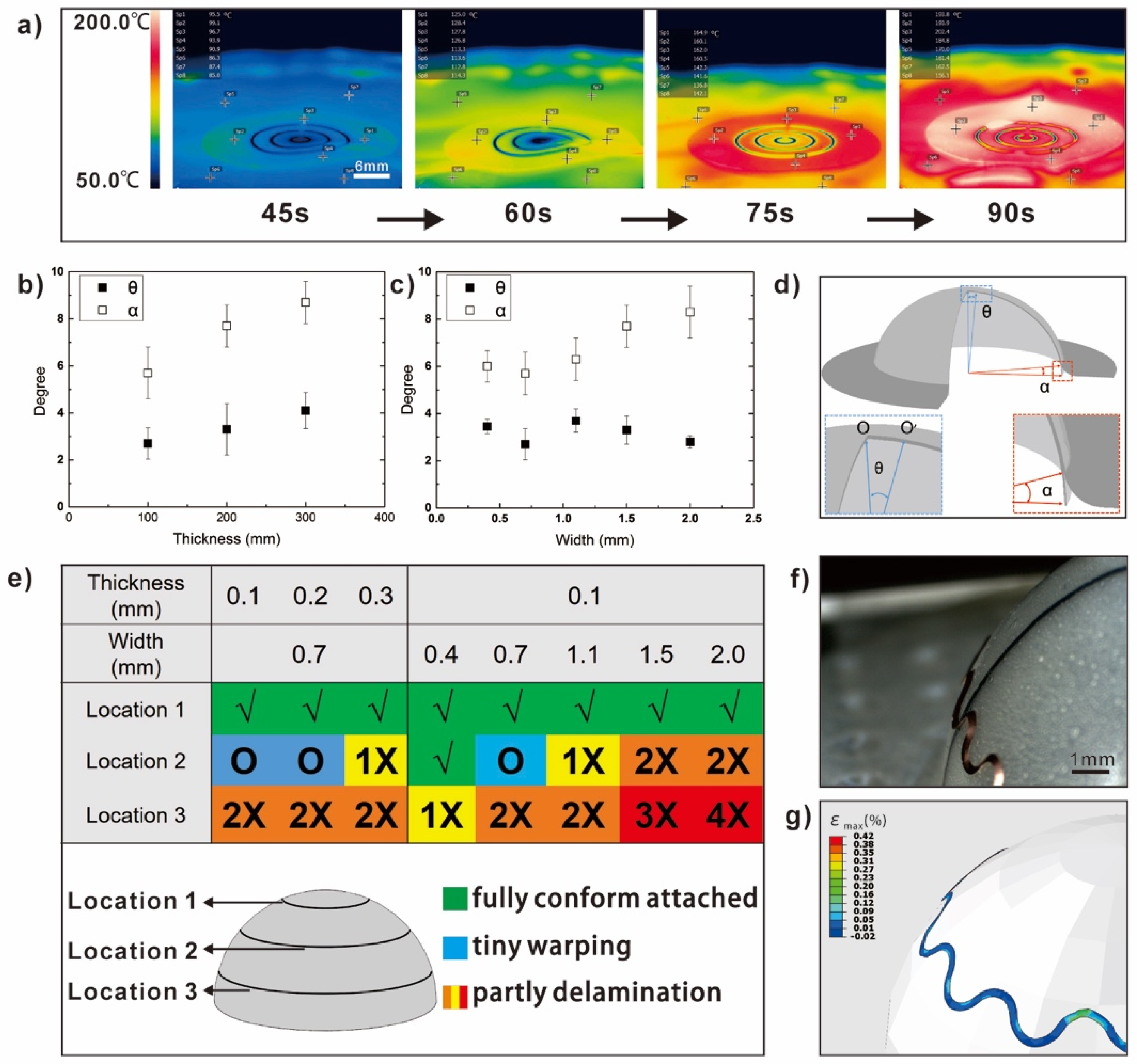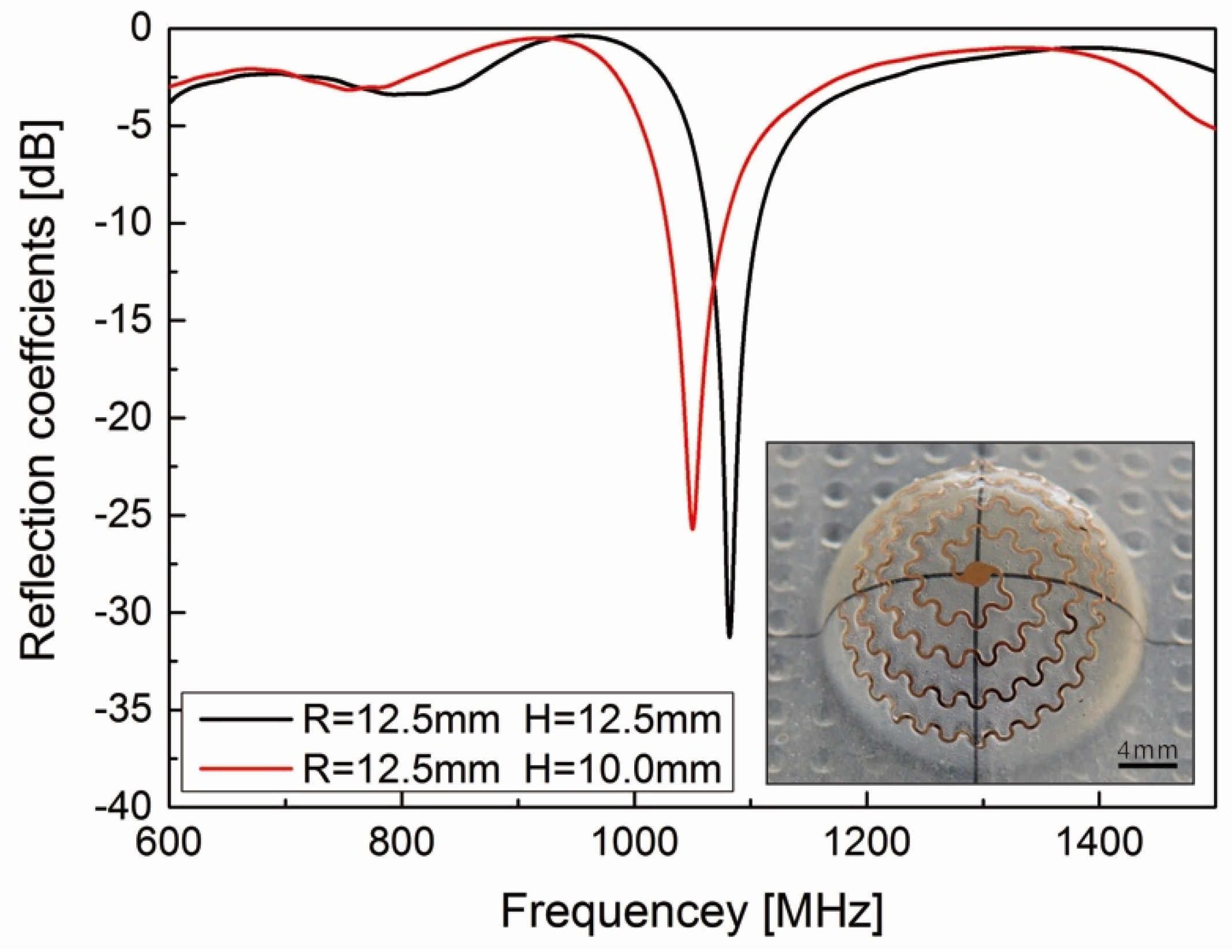High Precision Thermoforming 3D-Conformable Electronics with a Phase-Changing Adhesion Interlayer
Abstract
:1. Introduction
2. Materials and Methods
2.1. Visual Alignment and Optical Characterization
2.2. Film Morphology and Electrical Characteristic Performance Measurement
3. Results and Discussion
4. Electrical Performance of Fabricated Antennas
5. Conclusions
Supplementary Materials
Author Contributions
Funding
Acknowledgments
Conflicts of Interest
References
- Kaltenbrunner, M.; Sekitani, T.; Reeder, J.; Yokota, T.; Kuribara, K.; Tokuhara, T.; Drack, M.; Schwodiauer, R.; Graz, I.; Gogonea, S.B.; et al. An ultra-lightweight design for imperceptible plastic electronics. Nature 2013, 499, 458–463. [Google Scholar] [CrossRef] [PubMed]
- Huang, Z.; Hao, Y.; Li, Y.; Hu, H.; Wang, C.; Nomoto, A.; Pan, T.; Gu, Y.; Chen, Y.; Zhang, T.; et al. Three-dimensional integrated stretchable electronics. Nat. Elect. 2018, 1, 473–480. [Google Scholar] [CrossRef]
- Huang, Y.; Wu, H.; Xiao, L.; Duan, Y.; Zhu, H.; Bian, J.; Ye, D.; Yin, Z. Assembly and Application of 3D Conformal Electronics on Curvilinear Surface. Mater. Horiz. 2019, in press. [Google Scholar] [CrossRef]
- Kim, D.H.; Lu, N.; Ma, R.; Kim, Y.S.; Kim, R.H.; Wang, S.; Wu, J.; Won, S.M.; Tao, H.; Islam, A.; et al. Epidermal electronics. Science 2011, 333, 838–843. [Google Scholar] [CrossRef] [PubMed]
- Yoon, J.; Li, L.; Semichaevsky, A.V.; Ryu, J.H.; Johnson, H.T.; Nuzzo, R.G.; Rogers, J.A. Flexible concentrator photovoltaics based on microscale silicon solar cells embedded in luminescent waveguides. Nat. Commun. 2011, 2, 343. [Google Scholar] [CrossRef] [PubMed] [Green Version]
- Lee, H.E.; Choi, J.; Lee, S.H.; Jeong, M.; Shin, J.H.; Joe, D.J.; Kim, D.; Kim, C.W.; Park, J.H.; Lee, J.H.; et al. Monolithic Flexible Vertical GaN Light-Emitting Diodes for a Transparent Wireless Brain Optical Stimulator. Adv. Mater. 2018, 30, 1800649. [Google Scholar] [CrossRef] [PubMed]
- Park, J.H.; Seo, J.; Kim, C.; Joe, D.J.; Lee, H.E.; Im, T.H.; Seok, J.Y.; Jeong, C.K.; Ma, B.S.; Park, H.K.; et al. Flash-Induced Stretchable Cu Conductor via Multiscale-Interfacial Couplings. Adv. Sci. 2018, 5, 1801146. [Google Scholar] [CrossRef] [PubMed]
- Tao, H.; Brenckle, M.A.; Yang, M.; Zhang, J.; Liu, M.; Siebert, S.M.; Averitt, R.D.; Mannoor, M.S.; McAlpine, M.C.; Rogers, J.A.; et al. Silk-Based Conformal, Adhesive, Edible Food Sensors. Adv. Mater. 2012, 24, 1067–1072. [Google Scholar] [CrossRef] [PubMed]
- Adams, J.J.; Duoss, E.B.; Malkowski, T.F.; Motala, M.J.; Ahn, B.Y.; Nuzzo, R.G.; Bernard, J.T.; Lewis, J.A. Conformal Printing of Electrically Small Antennas on Three-Dimensional Surfaces. Adv. Mater. 2011, 23, 1335–1340. [Google Scholar] [CrossRef] [PubMed]
- Yu, Y.; Liu, F.; Zhang, R.; Liu, J. Suspension 3D Printing of liquid metal into self-healing hydrogel. Adv. Mater. Technol. 2017, 2, 1700173. [Google Scholar] [CrossRef]
- Jobs, M.; Hjort, K.; Rydberg, A.; Wu, Z. A Tunable Spherical Cap Microfluidic Electrically Small Antenna. Small 2013, 9, 3230–3234. [Google Scholar] [CrossRef] [PubMed]
- Rogers, J.A.; Someya, T.; Huang, Y. Materials and mechanics for stretchable electronics. Science 2010, 327, 5973. [Google Scholar] [CrossRef] [PubMed]
- Hussain, A.M.; Ghaffar, F.A.; Park, S.I.; Rogers, J.A.; Shamim, A.; Hussain, M.M. Metal/polymer based stretchable antenna for constant frequency far-field communication in wearable electronics. Adv. Funct. Mater. 2015, 25, 6565–6575. [Google Scholar] [CrossRef]
- Throne, J.L. Understanding Thermoforming; Hanser: Munich, Germany, 2008. [Google Scholar]
- Vanfleteren, J.; Gonzalez, M.; Bossuyt, F.; Hsu, Y.Y.; Vervust, T.; Wolf, I.D.; Jablonski, M. Printed circuit board technology inspired stretchable circuits. MRS Bull. 2012, 37, 254–260. [Google Scholar] [CrossRef] [Green Version]
- Wu, Z.; Jobs, M.; Rydberg, A.; Hjort, K. Hemispherical coil electrically small antenna made by stretchable conductors printing and plastic thermoforming. J. Micromech. Microeng. 2015, 2, 027005. [Google Scholar]
- Vanfleteren, J.; Plovie, B.; Yang, Y.; Smet, J.D.; Verplancke, R.; Bossuyt, F.; Smet, H.D. Free-form 2.5D thermoplastic circuits using one-time stretchable interconnections. Mater. Res. Soc. 2015, 1798. [Google Scholar] [CrossRef] [Green Version]
- Plovie, B.; Yang, Y.; Guillaume, J.; Dunphy, S.; Dhaenens, K.; Steven, V.P.; Vandecasteele, B.; Vervust, T.; Bossuyt, F.; Vanfleteren, J. Arbitrarily Shaped 2.5D Circuits using Stretchable Interconnects Embedded in Thermoplastic Polymers. Adv. Eng. Mater. 2017, 19, 1700032. [Google Scholar] [CrossRef]
- Xu, X.; Davanco, M.; Qi, X.; Forrest, S.R. Direct transfer patterning on three dimensionally deformed surfaces at micrometer resolutions and its application to hemispherical focal plane detector arrays. Org. Electron. 2008, 9, 1122–1127. [Google Scholar] [CrossRef]
- Le Borgne, B.; De Sagazan, O.; Crand, S.; Jacques, E.; Harnois, M. Conformal Electronics Wrapped Around Daily Life Objects Using an Original Method: Water Transfer Printing. ACS Appl. Mater. Interfaces 2017, 9, 29424–29429. [Google Scholar] [CrossRef] [PubMed] [Green Version]
- Le Borgne, B.; Jacques, E.; Harnois, M. The Use of a Water Soluble Flexible Substrate to Embed Electronics in Additively Manufactured Objects: From Tattoo to Water Transfer Printed Electronics. Micromachines 2018, 9, 474. [Google Scholar] [CrossRef] [PubMed]
- Gonzalez, M.; Axisa, F.; Bulcke, M.V.; Brosteaux, D.; Vandevelde, B.; Vanfleteren, J. Design of metal interconnects for stretchable electronics circuits. Microelectron. Reliab. 2008, 48, 825. [Google Scholar] [CrossRef]
- Hsu, Y.Y.; Gonzalez, M.; Bossuy, F.; Axisac, F.; Vanfleteren, J.; Wolf, I.D. The effects of encapsulation on deformation behavior and failure mechanism of stretchable interconents. Solid Films 2011, 7, 2225–2234. [Google Scholar] [CrossRef]
- Mosallaei, M.; Jokinen, J.; Kanerva, M.; Mäntysalo, M. The effect of encapsulation geometry on the performance of stretchable interconnects. Micromachines 2018, 9, 645. [Google Scholar] [CrossRef] [PubMed]
- Li, K.; Cheng, X.; Zhu, F.; Li, L.; Xie, Z.; Luan, H.; Wang, Z.; Ji, Z.; Wang, H.; Liu, F.; et al. A generic soft encapsulation strategy for stretchale electronics. Adv. Fucnt. Mater. 2019, in press. [Google Scholar]
- Lee, C.; Ma, Y.; Jang, K.; Banks, A.; Pan, T.; Feng, X.; Kim, J.S.; Kang, D.; Raj, M.S.; McGrane, B.L.; et al. Soft Core/shell packages for stretchable electronics. Adv. Funct. Mater. 2015, 25, 3698–3704. [Google Scholar] [CrossRef]
- Pan, P.; Pharr, M.; Yinji, M.; Rui, N.; Zheng, Y.; Renxiao, X.; Xue, F.; Yonggang, H.; Rogers, J.A. Experimental and Theoretical studies of serpentine interconnects on ultrathin elastomers for stretchable electronics. Adv. Funct. Mater 2017, 27, 1702589. [Google Scholar] [CrossRef]
- Liu, F.; Chen, Y.; Song, H.; Zhang, F.; Fan, Z.; Liu, Y.; Feng, X.; Rogers, J.A.; Huang, Y.; Zhang, Y. High Performance, Tunable Electrically Small Antennas through Mechanocally Guided 3D Assembly. Small 2018, 15, 1804055. [Google Scholar] [CrossRef] [PubMed]
- Oh, D.W.; Kim, S.; Rogers, J.A.; Cahill, D.G.; Sinha, S. Interfacial Thermal conductance of transfer-printed metal films. Adv. Mater. 2011, 23, 5028–5033. [Google Scholar] [CrossRef] [PubMed]
- Liu, R.; Li, Y.; Lu, C.; Song, J.; Saeidpouraza, R.; Fang, B.; Zhong, Y.; Ferreira, P.M.; Rogers, J.A.; Huang, Y. Thermo-mechanical modeling of laser-driven non-contact transfer printing: Two-dimensional analysis. Soft Mater. 2012, 8, 3122. [Google Scholar]
- Lee, H.E.; Lee, D.; Lee, T.; Shin, J.H.; Choi, G.M.; Kim, C.; Lee, S.H.; Lee, J.H.; Kim, Y.H.; Kang, S.M.; et al. Wireless powered wearable micro light-emitting diodes. Nano Energy 2019, 55, 454–462. [Google Scholar] [CrossRef]





© 2019 by the authors. Licensee MDPI, Basel, Switzerland. This article is an open access article distributed under the terms and conditions of the Creative Commons Attribution (CC BY) license (http://creativecommons.org/licenses/by/4.0/).
Share and Cite
Wu, K.; Zhou, Q.; Zou, H.; Leng, K.; Zeng, Y.; Wu, Z. High Precision Thermoforming 3D-Conformable Electronics with a Phase-Changing Adhesion Interlayer. Micromachines 2019, 10, 160. https://doi.org/10.3390/mi10030160
Wu K, Zhou Q, Zou H, Leng K, Zeng Y, Wu Z. High Precision Thermoforming 3D-Conformable Electronics with a Phase-Changing Adhesion Interlayer. Micromachines. 2019; 10(3):160. https://doi.org/10.3390/mi10030160
Chicago/Turabian StyleWu, Kang, Qifeng Zhou, Huaping Zou, Kangmin Leng, Yifan Zeng, and Zhigang Wu. 2019. "High Precision Thermoforming 3D-Conformable Electronics with a Phase-Changing Adhesion Interlayer" Micromachines 10, no. 3: 160. https://doi.org/10.3390/mi10030160



